The MGA With An Attitude
Another Look at BAD VALVES -- CH-101A
On 4/4/2010, J. D. Sutcliffe wrote:
"I've attached a number of before and after shots and I was wondering if you could tell me if the valve seats etc look good, bad or indifferent. I have gone this far should I just go and get them reground"?
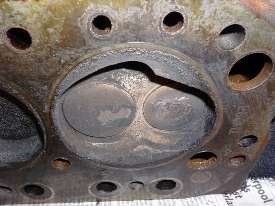
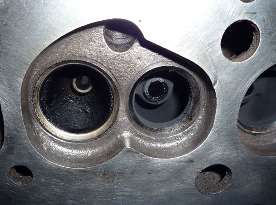
The #1 exhaust valve is significantly recessed (above left). When new and in good condition the valve heads would stand proud of the chamber floor (ceiling) by at least 1/32 inch. Running your finger over the edge of the valve head should show it to be raised slightly. Going down to be flat or flush with the casting surface is not great, but may be considered normal wear after lots of miles, and is likely still serviceable. When the valve head becomes recessed below the surrounding surface it is particularly bad.
The #1 exhaust port and seat shows excessively wide seat land area (above right). When new it would have three surfaces, flat across the surface parallel to the valve head, vertical down the wall of the cylindrical port bore, and a 45 degree angle between those surfaces that serves as the seat for the valve head (called the "land"). When new the land should be 1.0-1.5mm wide (0.040-0.060 inch). As the seat wears the land gets wider. When it gets wider than about 3mm (0.120") it can cause problems.
The issue is seat pressure, as in PSI or force per unit area between the valve head and seat mating surfaces. Spring force remains constant, so as the land gets wider the pressure is reduced. When surface pressure is low it can accumulate carbon deposits on the mating surfaces. The carbon can then flake off or develop small cracks that will cause compression leakage. Hot exhaust gases then pass though the void like a cutting torch resulting in rapid erosion of the mating surfaces, burned valves and compression loss.

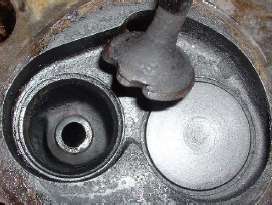
As it gets worse the wear accelerates. In severe cases is can chew a big notch in the edge of the valve head to look like it was hit with an ax. In less severe cases (more common) the seat just wears deeper and deeper into the head until the land may get to be as wide as the bevel on the edge of the valve head, and seat pressure becomes very low (photo at top of page). Eventually the valve recesses so deep into the head that you run out of adjusting range for the rocker arm valve lash adjusting screw. When you end up with near zero valve clearance the valves don't close all the way, and then they burn like crazy.
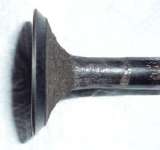 This picture shows the result of wear and erosion on the valve head. Originally the 45 degree conical surface is perfectly straight, and it contacts the seat only on a narrow spot (width of land when new). It may be a toss up as to which wears faster, valve head or valve seat, depending on construction materials. If the valve head might wear slightly it will develop a small groove where it mates with the seat. As wear progresses the groove gets deeper and wider as the seat wears to be wider. End result can be a concave shape on the seating surface of the valve head. Exhaust valves take a worse beating than intake valves due to higher heating of the exhaust parts with passage of hot exhaust gasses (and cooling of intake parts with intake air flow). Using hard surfaced Stellite exhaust valves may nearly eliminate this type of wear on the valve head.
This picture shows the result of wear and erosion on the valve head. Originally the 45 degree conical surface is perfectly straight, and it contacts the seat only on a narrow spot (width of land when new). It may be a toss up as to which wears faster, valve head or valve seat, depending on construction materials. If the valve head might wear slightly it will develop a small groove where it mates with the seat. As wear progresses the groove gets deeper and wider as the seat wears to be wider. End result can be a concave shape on the seating surface of the valve head. Exhaust valves take a worse beating than intake valves due to higher heating of the exhaust parts with passage of hot exhaust gasses (and cooling of intake parts with intake air flow). Using hard surfaced Stellite exhaust valves may nearly eliminate this type of wear on the valve head.
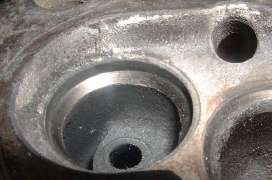 This picture shows the result of severe valve seat recession. This has progressed to the point of the seats being as wide as the bevel on the valve head, and the seats are worn very deep into the head casting. The only cure for this to bore out the valve seat an install new seat rings. While you're at it you might as well install hardened steel valve seats, as the difference in cost is nil compared to the labor charge. Installing hardened steel valve seats can make the seats last much longer, usually in excess of 100,000 miles even when running unleaded fuel.
This picture shows the result of severe valve seat recession. This has progressed to the point of the seats being as wide as the bevel on the valve head, and the seats are worn very deep into the head casting. The only cure for this to bore out the valve seat an install new seat rings. While you're at it you might as well install hardened steel valve seats, as the difference in cost is nil compared to the labor charge. Installing hardened steel valve seats can make the seats last much longer, usually in excess of 100,000 miles even when running unleaded fuel.
One more thing. Place a valve stem back into the valve guide and wiggle the valve head sideways. When new the running clearance in the guide would be in the range of 0.0010" to 0.0025", and the head might wiggle 0.003" (thickness of a sheet of paper). I will bet your valves will wiggle at least 1/32" and maybe more, indicating worn valve guides (very common). When replacing valve guides I highly recommend using bronze guides. This will greatly reduce wear in the guides to the extent of possibly running 100,000 miles and still being serviceable for another 100,000 after a valve touch up. One caution with bronze guides. They have a higher rate of thermal expansion, so they need more running clearance to avoid seizing the vales when hot. Clearance here should be 0.0020" minimum, and I wouldn't be shy about making it 0.0030". Wear in bronze guides will be so little that even when starting with 0.0030" clearance they will have closer fit after 20,000 miles than worn iron guides.
And while you have the head off, you should drop the tappets back in the bores and measure cam lift. Cam lobe height for stock cam is 0.250" from base circle to crest of the lobe. Rocker arm mechanical ratio is 1.42:1, giving valve lift of 0.355" (with zero clearance of the rocker arm). You can measure lift with a long travel dial indicator to be accurate. In a pinch you might measure lift with a steel rule and a sharp eye. When cam is out of the block you can measure the base circle and lobe height with a dial caliper or micrometer. Hard surfacing of the cam lobes is only skin deep. Once wear on a cam lobe progresses more than about 0.003" it may be through the hard surface and into softer material, after which wear will progress much faster. If you find any one cam lobe to be more than 0.005" shorter than others, it's time for a new cam and tappets.
|